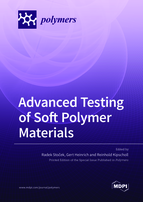Advanced Testing of Soft Polymer Materials
A special issue of Polymers (ISSN 2073-4360). This special issue belongs to the section "Polymer Analysis and Characterization".
Deadline for manuscript submissions: closed (25 June 2022) | Viewed by 29041
Special Issue Editors
2. Assoc. Prof. Dr.-Ing., Centre of Polymer Systems, Tomas Bata University in Zlín, tř. Tomáše Bati, 5678 Zlín, Czech Republic
Interests: rubber material; testing; fatigue, fracture, friction and wear characterization of elastomers; characterisation of crack initiation and propagation in elastomers; development of advanced testing methodologies, hardware and equipment; engineering applications; rubber compound development
Special Issues, Collections and Topics in MDPI journals
2. Faculty of Mechanical Science and Engineering, Technische Universität Dresden, 01069 Dresden, Germany
Interests: polymer nanocomposites; friction and adhesion of polymer systems, wear; fracture mechanical characterization and modelling of crack formation and propagation in elastomers; statistical-mechanics of polymer networks, material laws, engineering applications; rubber elasticity and viscoelasticity of filled polymer networks; filler-polymer and filler-filler interactions in elastomers: modelling, testing, engineering applications; tire physics, mechanics and engineering (e.g. traction and braking, road-tire interactions), advanced tire materials compounding and testing
Special Issues, Collections and Topics in MDPI journals
2. PRL Polymer Research Lab, s.r.o., Nad Ovcirnou 3685, 76001 Zlín, Czech Republic
Interests: development of advanced testing methodologies, hardware and equipment; engineering applications; fatigue, fracture, friction and wear characterization of elastomers
Special Issue Information
Dear Colleagues,
Manufactures of rubber products and suppliers of polymers and raw materials are forced to apply predictive and advanced laboratory test methods and experiments when seeking for high-performance elastomers for future rubber products, as well as for better understanding of the overall materials properties. Ideally, predictive laboratory tests should balance accuracy, relevance, and instrument productivity. They should establish a connection to fundamental scientific principles that even show how test results from a simple piece of uncured rubber and/or a sheet of cured rubber are related to the realistic geometry and loading conditions of the final rubber product under service conditions. The rapid advancement of simulation tools is one way to do this, and several new advanced testing methods created new opportunities to link materials laboratory testing data to a real-world rubber product performance.
We encourage authors to publish high value manuscripts related to the characterisation of soft rubbery materials. These manuscripts should be related (i) to the development and use of newly developed and/or unique resp. advanced rubber testing methods, and (ii) to predictive testing and real loading simulation concepts where complex information about the materials and final product performance in an early stage will be compiled. More specifically, the desired topics about advanced rubber testing methods and equipment in this special issue should illustrate progress in fields like mechanical testing, dynamic-mechanical and thermal analysis, dielectric testing, NMR, spectroscopy, advanced optical methods, numerical and physical modeling of rubber testing, fracture and fatigue analysis and wear prediction, rubber friction testing, numerical and physical modeling of rubber testing methods, etc.
Assoc. Prof. Radek Stoček
Prof. Dr. Gert Heinrich
Dipl.-Ing. Reinhold Kipscholl
Guest Editors
Manuscript Submission Information
Manuscripts should be submitted online at www.mdpi.com by registering and logging in to this website. Once you are registered, click here to go to the submission form. Manuscripts can be submitted until the deadline. All submissions that pass pre-check are peer-reviewed. Accepted papers will be published continuously in the journal (as soon as accepted) and will be listed together on the special issue website. Research articles, review articles as well as short communications are invited. For planned papers, a title and short abstract (about 100 words) can be sent to the Editorial Office for announcement on this website.
Submitted manuscripts should not have been published previously, nor be under consideration for publication elsewhere (except conference proceedings papers). All manuscripts are thoroughly refereed through a single-blind peer-review process. A guide for authors and other relevant information for submission of manuscripts is available on the Instructions for Authors page. Polymers is an international peer-reviewed open access semimonthly journal published by MDPI.
Please visit the Instructions for Authors page before submitting a manuscript. The Article Processing Charge (APC) for publication in this open access journal is 2700 CHF (Swiss Francs). Submitted papers should be well formatted and use good English. Authors may use MDPI's English editing service prior to publication or during author revisions.
Keywords
- Advanced testing methods
- Polymers
- Elastomers
- Fatigue
- Fracture
- Friction
- Wear
- Testing equipment
- Testing methodologies
- Development of methods
- Quasistatic mechanical testing
- Dynamic-Mechanical Testing
- Thermodynamical / Caloric Testing
- Dielectric Testing
- NMR
- X-ray and neutron-scattering
- Spectroscopy
- Advanced optical methods
- Numerical and Physical Modelling of rubber testing methods







